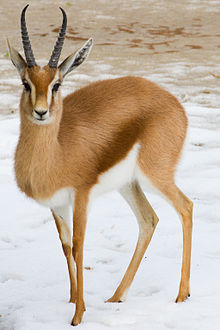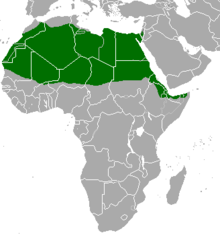Dorcas Gazelle
| Dorcas gazelle | |
|---|---|
 |
|
| Scientific classification | |
| Kingdom: | Animalia |
| Phylum: | Chordata |
| Class: | Mammalia |
| Order: | Artiodactyla |
| Family: | Bovidae |
| Subfamily: | Antilopinae |
| Genus: | Gazella |
| Species: | G. dorcas |
| Binomial name | |
|
Gazella dorcas (Linnaeus, 1758) |
|
 |
|
| Gazella dorcas range | |
The dorcas gazelle (Gazella dorcas), also known as the ariel gazelle, is a small and common gazelle. The dorcas gazelle stands about 55–65 cm (1.8-2.1 ft) at the shoulder, with a head and body length of 90–110 cm (3-3.6 ft) and a weight of 15–20 kg (33-44 lb). The numerous subspecies survive on vegetation in grassland, steppe, wadis, mountain desert and in semidesert climates of Africa and Arabia. About 35,000 - 40,000 exist in the wild. The extinct Saudi gazelle from the Arabian Peninsula has been previously considered as a subspecies of the dorcas gazelle.
The scientific name of the dorcas gazelle is Gazella dorcas. It is a member of the genus Gazella and the family Bovidae. The species was first described by Swedish zoologist Carl Linnaeus in the 10th edition of Systema Naturae in 1758.
Although zoologist Theodor Haltenorth considered G. d. pelzelnii to be an independent species, the following six subspecies are identified:
Illustration of G. d. dorcas.
Illustration of G. d. isabella
Illustration of G. d. pelzelni
The dorcas gazelle is similar in appearance to, yet smaller than, the closely related mountain gazelle (Gazella gazella). Dorcas gazelles have longer ears and more strongly curved horns, which bow outwards then turn inwards and forwards at the tips. Individuals belonging to the Saharan subspecies (G. d. osiris) have very pale, fawn-colored coats. The white underside is bordered with a brown stripe, above which is a sandy stripe. The forehead and face are darker than the body. Subspecies from north of the Sahara tend to be more ochre in color, and have dark flanks and facial stripes. Populations in Israel and around the Red Sea are darker and more reddish. In the last century, the populations of dorcas gazelle were partially destroyed in all the countries where it was found.
...
Wikipedia

